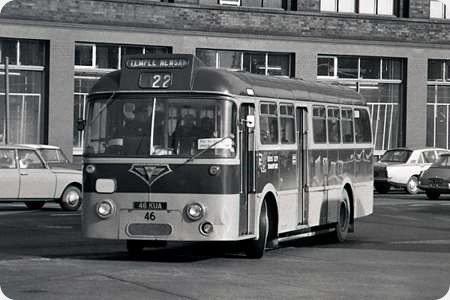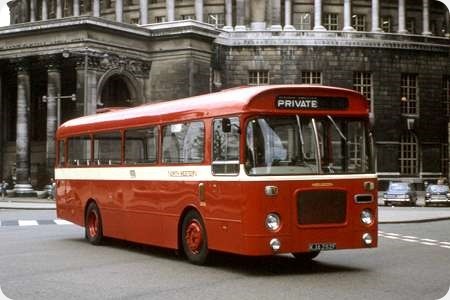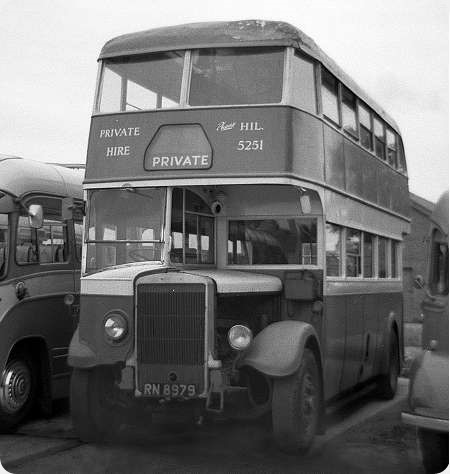Leeds City Transport – AEC Reliance – KUA 46 – 46
Leeds City Transport
1964
AEC Reliance 2MU2RA
Roe B41D
Seen in April 1970 is Leeds City Transport No. 46, 46 KUA, an AEC Reliance 2MU2RA with Roe B41D bodywork, one of four, Nos. 44 – 47, 44 – 47 KUA delivered in 1964. These followed an earlier order for six similar vehicles in 1962, Nos 39 – 43, 839 – 843 CUM. I understand that all these Reliances had quite a short life of around 8 years or so with Leeds.
Photograph and Copy contributed by Roger Cox
03/12/18 – 07:13
I can’t comment on the others, but 45 and 47 went to Aberdeen. I have a view of each from the late Arnold Richardson’s collection.
Pete Davies
04/12/18 – 06:33
All four were new in August 1964 and withdrawn in December 1970.
44 and 45 went to Aberdeen on 30th June 1971, being followed on 7th July by 46 and 47, retaining the same fleet numbers.
John Kaye
05/12/18 – 07:46
Oh dear, that destination box doesn’t look comfortable, balanced up there.
Petras409
11/12/18 – 07:43
These Reliance’s really came too late. They were in effect an update of the standee single deckers 29-38, to the same 30ft. length when 36 ft. had become available. Getting 41seats into the shorter length, with dual doors meant they had poor access/exit and tight seat spacing. As with many AECs of that design they were not comfortable, or liked by passengers or drivers. Just two years later, the first 36 ft. Swifts with wider doors, easier steps and 48 better spaced seats arrived. They may not have been great, but they were better. In a year or so there were 50 Swifts in operation and 39 to 46 were consigned to relief work and then sale.
Andy Buckland
13/12/18 – 05:53
Several of these also ended up in Scotland with Greyhound of Arbroath.
Chris Hough
07/01/19 – 07:12
I’ve sometimes wondered what was so wrong with the AEC Swift and the Leyland Panther that caused many operators to not get on with them, prematurely retire them (especially London’s AECs) and overall have bad experiences, while the conceptually similar Bristol RE seems to have commonly led a full life with its original operators.
It’s not as if they did not incorporate standard components in use elsewhere.
Bill
12/01/19 – 08:23
In the absence of a more comprehensive reply from someone who knows more, I will say that one of the differences between Bristol’s approach and the Panther/Swift approach was the position of the driveline and its effect on weight distribution. In the Panther and Swift the engine and gearbox were at the extreme rear of the overhang, whereas the RE had the engine further forward, with the gearbox in front of the rear axle.
Peter Williamson
16/01/19 – 07:27
The Panther also had a much weaker frame causing bending and breaking. Even in preservation I can think of a couple where following you can see the curve.
Roger Burdett
17/01/19 – 07:09
The radiator for the Swift was not at the front, as in the Panther or the RE, but tucked away behind a panel in the bodywork behind the offside back wheels.
Although this arrangement probably insured against air locks in the cooling system, it restricted the flow of cooling air over the surface of the radiator and could result in the engine overheating.
John B
18/01/19 – 06:30
My Foden which has the Rad in the same position still airlocks so concur John B comment.
Roger Burdett
18/01/19 – 06:32
In the Bristol RE the drive went forward from the engine to the gearbox located in front of the rear axle, and then back again to the differential. This gave a prop shaft of decent length to accommodate the suspension travel of the rear axle, something that competitive designs (the worst being the Seddon RU) lacked. Contrary to popular belief, the RE did not pioneer this layout. The Rutland Clipper of 1954 used a similar arrangement.
Roger Cox
Quick links to the - Comments Page - Contact Page - Home Page



